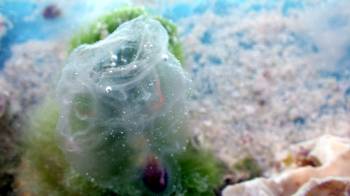Summary
Physical Description
Ecology
Life History & Behaviour
Feeding
Reproduction
Anatomy & Physiology
Sensory Systems (Focus Project)
Evolution & Systematics
Biogeographic Distribution
Conservation & Threats
References & Links |
Summary

|
|
|
Adult Pegea confoederata
(photo by Helen Twaddle, Heron Island)
|
Pegea confoederata is part of the class Thaliacea, a group of free-swimming, planktonic chordates that filter-feed to obtain their nutrition. As chordates, this group of animals are the group most related to vertebrate species (see Evolution & Systematics for more details). Unlike their sister-class, the Ascidiacea, who generally have both of their siphons on the same side of the body, Thaliacea have buccal and atrial siphons on anterior and posterior sides of the body respectively allowing the water current to assist with movement via jet propulsion (Ruppert et al. 2004).
Thaliacea reproduction rates are not limited by growth but rather, by food availability. Therefore, when phytoplankton is blooming, Thaliacea may appear all of a sudden in massive numbers (Ruppert et al. 2004).
Unfortunately, due to the delicate, gelatinous form that salps take, they are infinitely harder to study than other common plankton species as they are hard to capture without damaging the organisms (Alldredge and Madin 1982). Therefore, salp species such as Pegea confoederata are vastly understudied and there is still a lot to learn.
|
|